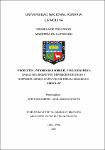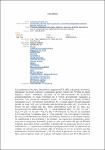Mostrar el registro sencillo del ítem
Productos antiobesidad sobre el peso, bioquímica sanguínea, biometría, deposición de grasa y expresión génica en ratas Holtzman inducidas a obesidad
| dc.contributor.advisor | Vergara Rubin, Víctor Jesús | |
| dc.contributor.author | Uculmana Morales, Cristian Gabriel | |
| dc.date.accessioned | 2018-12-31T13:05:31Z | |
| dc.date.available | 2018-12-31T13:05:31Z | |
| dc.date.issued | 2018 | |
| dc.identifier.other | L73.U3-T BAN UNALM | |
| dc.identifier.uri | https://hdl.handle.net/20.500.12996/3766 | |
| dc.description | Universidad Nacional Agraria La Molina. Escuela de Posgrado. Maestría en Nutrición | es_PE |
| dc.description.abstract | Los parámetros de peso, bioquímica sanguínea (TG, HDL y glucosa), biometría, deposición de tejido adiposo y expresión génica relativa de PPARα en tejido hepático fueron evaluados después de la administración de productos antiobesogénicos en ratas Holtzman de 3 meses, previamente inducidas a obesidad. Los productos utilizados fueron: un nutraceútico (ácido linoleico conjugado, CLA), un fármaco (fenofibrato, F), un ácido graso monoiinsaturado (aceite de oliva, AO) y otro poliinsaturado (aceite de pescado, AP). El estudio se dividió en dos etapas (E): E1, dieta obesogénica (DO) por 30 días; E2, incorporación de tratamientos (T). T1: dieta estándar (DE); T2: DO; T3: DO + CLA; T4: DO + F; T5: DO + AO; T6: DO + AP. Para los T3, T5 y T6 se consideró 0.5 ml aceite/kg PV rata/día; para el T4 la dosis de F fue 100 mg/Kg PV rata/día. El consumo de alimento fue medido diariamente. Al final de la fase experimental, se sacrificaron a los animales y se tomaron las siguientes mediciones: peso, bioquímica sanguínea, biometría, grasa corporal y expresión del gen de PPARα (hígado). Los datos fueron sometidos a análisis de varianza bajo un DCA con 6 tratamientos y 7 repeticiones utilizando el programa MINITAB, la diferencia de medias se calculó con la prueba LSD. Al finalizar la E2 se encontró que los tratamientos tuvieron influencias (P<0.05) sobre la ganancia de peso, nivel de HDL, grasa inguinal, total y en el peso del hígado, mas no así (P>0.05) sobre el peso final ni en variables biométricas. Se encontró una tendencia (0.05<P<0.1) en la expresión relativa de PPARα, donde el T6 tuvo el mayor valor y el T1 tuvo el menor valor. Se concluye que los productos evaluados tienen diferentes efectos benéficos a nivel de metabolismo y expresión génica relativa incluso bajo condiciones alimentarias desfavorables. | es_PE |
| dc.description.abstract | The parameters of weight, blood biochemistry (TG, HDL and glucose), biometry, deposition of adipose tissue and relative gene expression of PPARα in liver tissue were evaluated after the administration of antiobesgenic products in Holtzman rats of 3 months, previously induced to obesity. The products used were: a nutraceutical (conjugated linoleic acid, CLA), a drug (fenofibrate, F), a monounsaturated fatty acid (olive oil,OO) and another polyunsaturated (fish oil, FO). The study was divided into two stages (S): S1, obesogenic diet (OD) for 30 days; S2, incorporation of treatments (T). T1: standard diet (SD); T2: OD; T3: OD + CLA; T4: OD + F; T5: OD + OO; T6: OD + FO. For T3, T5 and T6, 0.5 ml oil / kg PV rat / day was considered; for T4 the dose of F was 100 mg / Kg PV rat / day. Food consumption was measured daily. At the end of the experimental phase, the animals were sacrificed and the following measurements were taken: weight, blood biochemistry, biometrics, body fat and expression of the PPARα gene (liver). The data were subjected to analysis of variance under a DCA with 6 treatments and 7 repetitions using the MINITAB program, the difference in means was calculated with the LSD test. At the end of the S2 it was found that the treatments had influences (P <0.05) on the weight gain, HDL level, inguinal fat, total and liver weight, but not (P> 0.05) on the final weight nor in biometric variables. A trend (0.05 <P <0.1) was found in the relative expression of PPARα, where T6 had the highest value and T1 had the lowest value. It is concluded that the products evaluated have different beneficial effects at the level of metabolism and relative gene expression even under unfavorable food conditions. | en_US |
| dc.description.uri | Tesis | es_PE |
| dc.format | application/pdf | en_US |
| dc.language.iso | spa | es_PE |
| dc.publisher | Universidad Nacional Agraria La Molina | es_PE |
| dc.rights | info:eu-repo/semantics/openAccess | en_US |
| dc.rights.uri | https://creativecommons.org/licenses/by-nc-nd/4.0/ | * |
| dc.source | Universidad Nacional Agraria La Molina | es_PE |
| dc.source | Repositorio institucional - UNALM | es_PE |
| dc.subject | Ratas | es_PE |
| dc.subject | Animales de laboratorio | es_PE |
| dc.subject | Ganancia de peso | es_PE |
| dc.subject | Sobrepeso | es_PE |
| dc.subject | Sangre | es_PE |
| dc.subject | Bioquímica | es_PE |
| dc.subject | Tejido adiposo | es_PE |
| dc.subject | Pérdida del peso | es_PE |
| dc.subject | Hígado graso | es_PE |
| dc.subject | Genes | es_PE |
| dc.subject | Proteínas | es_PE |
| dc.subject | Medición del cuerpo | es_PE |
| dc.subject | Investigación | es_PE |
| dc.subject | Perú | es_PE |
| dc.subject | Ratas obesas | es_PE |
| dc.subject | Productos antiobesogénicos | es_PE |
| dc.subject | Bioquímica sanguínea | es_PE |
| dc.subject | Deposición de grasas | es_PE |
| dc.subject | Expresión génica | es_PE |
| dc.subject | Ratas Holtzman | es_PE |
| dc.title | Productos antiobesidad sobre el peso, bioquímica sanguínea, biometría, deposición de grasa y expresión génica en ratas Holtzman inducidas a obesidad | es_PE |
| dc.type | info:eu-repo/semantics/masterThesis | en_US |
| thesis.degree.discipline | Nutrición | es_PE |
| thesis.degree.grantor | Universidad Nacional Agraria La Molina. Escuela de Posgrado | es_PE |
| thesis.degree.name | Magister Scientiae - Nutrición | es_PE |
| thesis.degree.level | Maestría | es_PE |
| dc.subject.ocde | https://purl.org/pe-repo/ocde/ford#4.04.01 | es_PE |
Ficheros en el ítem
Este ítem aparece en la(s) siguiente(s) colección(ones)
-
M-NUT Tesis [83]




